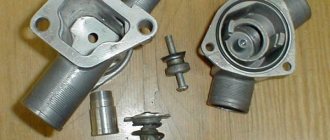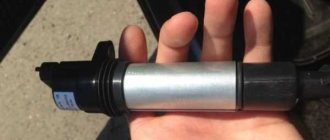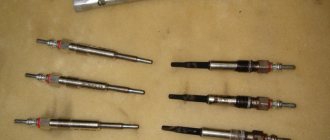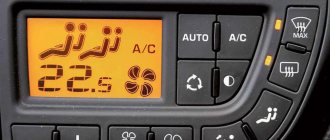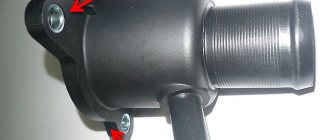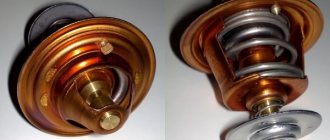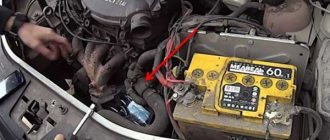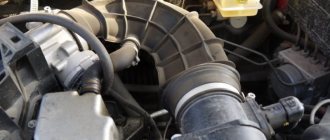Hi all! When the engine is running, it will definitely heat up. The colder the internal combustion engine, the more fuel it will need to consume. But the engine should not be allowed to overheat, since this is fraught with serious consequences. An important element in the power unit temperature control system is the thermostat. It may fail. Therefore, it would be logical to talk about how to check the operation of the thermostat and determine the malfunction of the unit.
Every motorist should know this, since such trouble can await you at any turn.
Previously, when talking about the reasons for engine overheating, one of the key points was the thermostat.
Today I’ll tell you in more detail about its functions, operating features, and also directly discuss the issue of self-checking without removing it.
What is it and how does it work
As you understand, the thermostat is a component of the cooling system of a car engine.
In short, the task of this element is to open and close the path for the movement of fluid that flows through a small or large circle.
The operation of the device is based on a physical phenomenon. Namely, on the expansion of the liquid when it is heated. The thermostat has a rather simple device, although in fact it is a sensor and an actuator in one bottle. It consists of a cylinder which is filled with a waxy liquid, powdered copper, aluminum and graphite. There is also a rod located inside the cylinder and a pair of spring-loaded valves. One valve is for the main (large) one, and the second is for the small circle of circulation of the cooling liquid.
During operation, this element is constantly exposed to the liquid that washes it. Heat is transferred to the contents of the cylinder.
When heating occurs, the wax in the cylinder expands, the rod is squeezed out along with the valve, marking the small circle. Thus, the small circulation circle is blocked, and the liquid begins to pass through the engine radiator, and not just through the stove radiator.
How to check a car's thermostat
There are two main ways to check a car's thermostat. One of them is carried out without removing the part, but requires a pyrometer, and the second is simpler, but the element will need to be removed from the engine during the test.
Checking the thermostat without removing it from the engine
As you know, the thermostat housing is connected to the upper radiator hose, which is included in a large circle of coolant circulation. Accordingly, with the thermostat working, after starting the engine, the upper radiator hose should remain cold (slightly warm) for some time until antifreeze is released through it.
To check the thermostat without removing it from the engine, get a pyrometer (temperature measuring device). You may come across the opinion that the check should be done without a device, measuring the temperature with your hands, but this is quite dangerous, given the large number of moving parts when the engine is running.
Point the pyrometer at the upper radiator hose and start the engine (cold start). For two or three minus periods, observe the device’s indicators. Next, draw a conclusion about the serviceability of the thermostat according to the following rules:
- The hose was cold for two or three minutes (or its temperature rose slightly), and then quickly warmed up. This indicates that the thermostat is working properly, and it switched the coolant circulation from a small circle to a large circle after the engine has sufficiently warmed up;
- The hose initially warmed up slowly. In this case, we can say that the thermostat is stuck in the open position and the antifreeze does not circulate in a small circle;
- The hose did not begin to warm up quickly after two or three minutes. That is, the thermostat is faulty and it does not switch the coolant circulation from a small circle to a large one.
Important: While checking the thermostat, monitor the engine temperature on the instrument panel. If the thermostat is stuck and won't keep the coolant flowing, the engine will start to overheat, which can lead to expensive parts failure.
Checking the thermostat in the pan
A widespread and well-known way to test the thermostat yourself is using a saucepan. As you might guess, before diagnostics you will need to remove the thermostat from the car engine and bring it home. After this, do the following:
- Take a pot and fill it with water;
- Inspect the thermostat housing and read the technical information on it, which indicates at what temperature it should switch;
- Hang the thermostat in the pan so that it is immersed in water, but does not touch the walls and bottom of the container, that is, it comes into contact only with water;
- Start heating the water and put a regular thermometer in it to measure the temperature of the liquid;
- When the water approaches the thermostat switching value from closed to open, make sure this happens. Also compare the thermometer reading, recording the temperature at which the coolant circuit switching valve opens with the ideal values indicated on the device body.
If the valve opens when heating water, track its behavior when cooling the liquid, checking at what temperature it returns to its original position. Based on the data obtained, draw a conclusion about the functionality of the thermostat.
Where is it located
There are many options for what will happen if the thermostat is constantly open on a large or small circle. This will lead to overheating, antifreeze may be released from the expansion tank, the normal pressure in the cooling system will change, and more.
This unit cannot be allowed to malfunction. It is used on all machines:
- on Kalina;
- on Priora;
- VAZ 2114;
- VAZ Classic;
- Ford Focus;
- VAZ 2110;
- Chevrolet Aveo;
- Gazelle Next;
- VAZ 2107;
- Lada Granta;
- Renault Logan, etc.
To check the serviceability of this element on a car, as well as to detect signs of a dying thermostat, you need to at least roughly understand where it is located.
I can't say it's difficult to do.
It is objectively correct to immediately look at the instruction manual. In the section where the cooling system is described, the location of the required element must be indicated.
At the same time, there is a fairly universal search method that is relevant for almost all domestic cars and many foreign cars.
To find a thermostat you need to do the following:
- open the hood;
- find the thickest pipe;
- this will be the radiator hose;
- it goes from the radiator to the engine;
- the second end of this pipe is connected to the thermostat;
- get to the second end;
- determine the location of the thermostat housing;
- start removing it.
Although I still advise you to first look at the manual, and only then start searching, dismantling and repair work.
Video. How to check the thermostat.
Similar material
KIT FOR QUICK REPAIR OF TUBELESS TIRES: features of selection and application
7 myths about storing car tires
History of Sumitomo tires / Sumitomo
History of Continental tires / Continental
Indian Motorcycles. The story of a legend.
How to fix a sagging door with non-adjustable hinges
Is it possible to install a larger capacity battery in a car?
5 ways to find out fuel consumption per 100 km
Algorithm for checking current leakage in a car
5 folk remedies for blackening rubber at home
Voltmeter for a car: how to connect and use correctly
The starter takes over: symptoms and causes
Starter inrush current: how to measure and why is it needed?
7 possible reasons why the BATTERY TERMINAL on a car is HEATING
5 options WHERE TO PLACE A USED BATTERY from a car
7 possible causes of chronic BATTERY UNDERCHARGE
7 ways to increase ON-BOARD VOLTAGE
BATTERY DESULFATION with a conventional charger
How to determine the actual BATTERY CAPACITY
Easy check of the engine cooling system without disassembly
5 ways to check your car's cooling system thermostat
33 tips on what to look for when buying a car
7 folk remedies for effectively removing bitumen stains from a car
The simplest do-it-yourself anti-theft (two schemes)
How to photograph a car for sale
How to drive a car in icy conditions and avoid getting into an accident
10 proven tips to extend the life of your car battery
How to restore a car battery or finish it off completely
How to choose a battery for a car - bad advice and misconceptions
How to charge a gel battery - answers to 5 important questions
7 mandatory rules for charging AGM batteries
20 reasons for steering wheel beating and vibration - troubleshooting techniques
Car battery desulfation
How to connect a voltmeter in a car and use it correctly
Trailer Krepysh: review and owner reviews
When starting a cold internal combustion engine, a small circle operates, which helps to warm up the engine and the interior heater faster. Having reached a certain temperature, the sensor is triggered and the system switches to a large circle, transferring engine heat to the internal combustion engine radiator. This prevents the motor from overheating. If the system jams and circulates fluid in a small circle, the engine will inevitably overheat and a number of other ensuing consequences will occur. That is, such situations cannot be allowed to arise.
If the thermostat fails, two main situations may occur.
In the first case, the thermostat switches the cooling system so that a large circulation circle is closed. As a result, the engine gets hot and the gauges on the dashboard go off scale. The motor may jam and related systems and components may fail.
The second situation is somewhat different. Here the thermostat is already stuck in the open position.
In this position, the coolant will constantly flow through a large circuit, affecting the radiator. If it is warm outside, this will not cause any significant problems for the car or the driver himself. So this is less of a reason to panic. But in winter, you will quickly notice that the thermostat is faulty. In cold weather, a power unit with a faulty coolant sensor will slowly warm up, fuel consumption will increase, the heater will not function properly, and the cabin will feel cold.
If you notice that the engine is overheating, or the interior is cold and the heater is not working, this largely indicates problems with an element such as the thermostat.
About the operating principle of the thermostat
The part is a heat-sensitive element that opens the damper when heated to a certain temperature (from 87 to 93 ° C). The actuator is triggered by the expansion of the working fluid - a special liquid that responds to changes in ambient temperature (in this case, antifreeze).
The thermostat with a hermetically sealed damper is usually placed in its own housing and is a separate part. But there are also open-frame products that are installed inside a designated channel in the engine. The operating algorithm is the same for all models:
- After starting a cold engine, the coolant flows in a small circle - through the water jacket of the power unit and the small heat exchanger of the stove. The passage to the main radiator is blocked by a damper, which speeds up engine warming up.
- When the set temperature threshold is reached, the damper begins to open, allowing part of the antifreeze to cool in the main radiator.
- When the engine warms up to operating temperature (over 90 °C), the passage opens completely and all the antifreeze moves along a large circulation circuit.
Primary signs of a thermostat malfunction come down to two symptoms: constant “boiling” or the inability to warm up the power unit, especially in winter.
Causes of stove malfunction
If it has been noticed that the efficiency of heating the interior of your Renault Logan has decreased, do not immediately panic. First you need to understand in detail what the problem is and find out the reasons. Depending on the nature of the malfunction, the interior heater may work poorly or not function at all. Let's look at the main reasons why the stove's performance is impaired:
- There is an air lock in the heating system.
- Thermostat failure.
- The pump is not working properly.
- The heater radiator is clogged.
- Problems with the heater motor.
Despite the apparent simplicity of solving these problems, they are the ones that most often force car owners to carry out independent repairs or contact a service center.
Why does the Renault Logan stove not heat up?
One of the common problems with the Renault Logan heating system is the lack of warm air from the deflectors, while the stove pipes remain hot. In addition to the reasons listed, the flow of heat into the cabin may be limited due to a clogged cabin filter. Since quite large debris, such as leaves, gets into the cavity of this element, the filter must be inspected and cleaned periodically.
Do-it-yourself dismantling and replacement of the Renault Logan stove One of the reasons that the stove pipes are hot and warm air does not enter the cabin is an air lock in the system
Common reasons why the stove does not heat include the failure of a resistor or heater fuse. Checking these elements will help determine their integrity and, in case of damage, replace them. If all of the above did not help determine the problem of poor functioning of the stove, check the contacts of the connector through which power is supplied to the fan motor.
